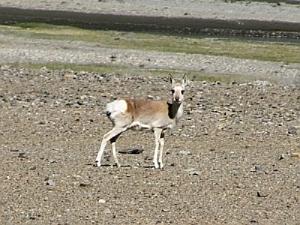Bindu Raghavan
Other projects
14 Jan 2010
Pastoralism, Disease & Wildlife Conservation in Ladakh- Prevalence of Infectious and Parasitic Diseases of Livestock and Wildlife
This project will involve a survey for Ladakh urial in its entire historical distribution range in Ladakh, to estimate the current population size, structure, status and distribution.

Tibetan gazelle near Hanle monastery.
The Ladakh urial (Ovis vignei vignei) is an endangered wild sheep (IUCN Red List 2006; Appendix I CITES; Schedule I Indian Wildlife (Protection) Act) endemic to the Trans-Himalayan region of Ladakh. Numerous even until the turn of the last century, the urial’s current population numbers only 1500-2000 individuals in the wild. It is now threatened by habitat loss and destruction, grazing competition and potential disease transfers from livestock, through changes in the socio-economic structure of the local human population, increasing livestock population, and changes in land-use patterns. Unlike other wild ungulates of Ladakh, the urial typically inhabits the lower altitudes (2500-4500m), areas closer to human habitations, and is therefore, more ‘prone’ to the ill- effects of human and livestock activity.

Pastoral herders with livestock in Chushul marshes, Ladakh.
The urial’s disappearance then will potentially signal the start of the end for other wild fauna of the region. But the urial’s proximity to humans also makes it a more “accessible” symbol of the local wild fauna and an ideal vehicle to spread the message of conservation. Hence, conservation of the urial is an important step for conservation of other fauna in Ladakh. Studies on Ladakh urial’s ecology have been very limited. There is still little known about the present status and distribution, or threats facing the population in its range in India.
This project will involve a survey for Ladakh urial in its entire historical distribution range in Ladakh, to estimate the current population size, structure, status and distribution. Information will also be collected on current threats to the urial population, livestock and human socio-economic data, and natural resource use patterns. This information will help evaluate the current status of the urial population in Ladakh and develop strategies for long-term monitoring, conservation and management of the Ladakh urial. Locals will be educated about the importance of conservation, especially urial conservation. Livestock herders, especially women and youth will also be trained to look for and monitor urial populations in their area. This will help raise awareness and enlist local participation and co-operation in urial conservation efforts.